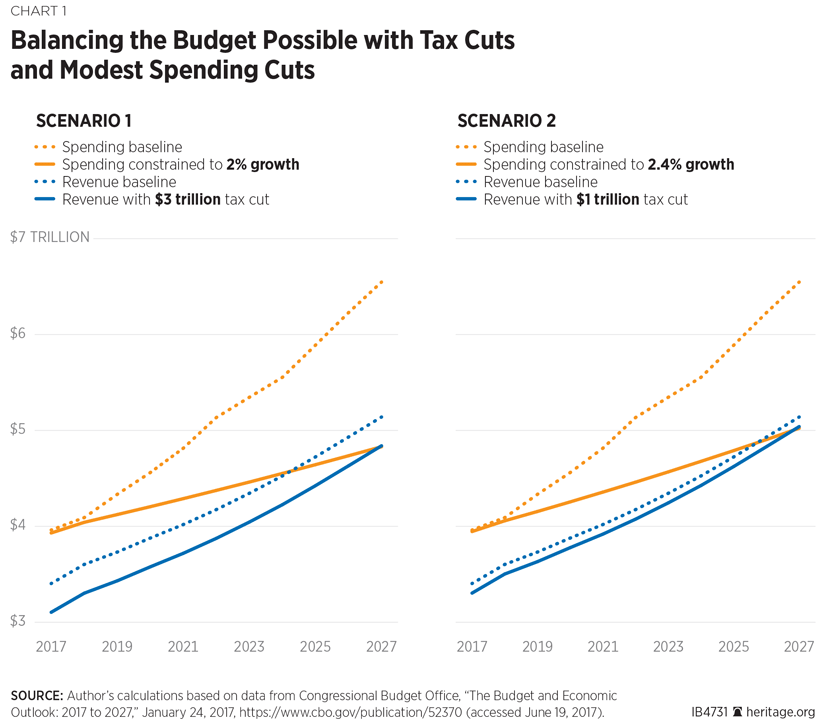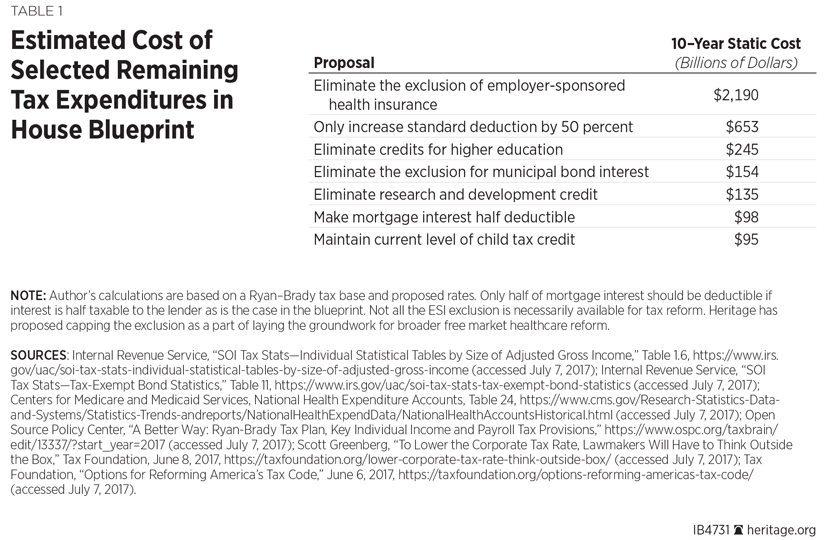Now is the time to update the U.S. tax code. However, the success of pro-growth tax reform faces political and procedural barriers. Most political observers see reconciliation, with the 2018 budget process as a vehicle, as the most likely path for tax reform.
The rules of reconciliation require tax reform to be deficit-neutral outside the budget window. Disagreement on how to meet this constraint has stalled congressional reform efforts. The House Republican Tax Reform Blueprint is a solid foundation for tax reform.[REF]
The House Blueprint strives to be deficit-neutral. However, its border adjustment tax (BAT) proposal is proving to be politically problematic and may even be economically counterproductive.[REF] One of the BAT’s features is that is raises about $1 trillion to help make tax reform deficit-neutral. This Issue Brief provides specific options to help the Blueprint through reconciliation without the BAT. Congress has a number of different options to fill the $1 trillion gap through additional revenue and spending offsets.[REF]
Slow the Growth of Government
Notwithstanding the need to actually reduce the size of government, Congress can keep the government in its current size and form while also cutting taxes.
Persistent deficits are the result of uncontrolled spending, not insufficient taxation. Without spending-based reforms, deficits will continue to grow, requiring still higher taxes in the future.
Deficits and debt in turn constrain tax reform efforts and unnecessarily turn any conversation on tax reform into a debate over achieving revenue neutrality. Reforming the tax code should not require finding new revenue sources; however, Table 1 below shows several economically sound options for tax-only reform.
Providing sustainable tax cuts, such as those proposed by President Donald Trump, is eminently achievable.[REF] Congress could balance the budget in 10 years and cut taxes by $3 trillion—without actually cutting the size of government.[REF] This can be done by limiting the assumed increase in the federal government’s annual spending to 2 percent each year—down from the 5.2 percent assumed growth rate in baseline outlays. A 2 percent growth rate would keep real spending constant, increasing enough to make up for inflation each year.
Federal outlays could continue to grow at 2.4 percent per year, fully offset a $1 trillion tax cut, and balance the budget in 10 years. While not recommended, a $1 trillion tax cut without the balanced budget constraint could be offset by slowing the growth of federal spending to just 4.7 percent—a half of a percentage point yearly reduction in the assumed growth of government.[REF]
Congress’ principal goal should be limiting the total burden of the federal government. Both tax and spending cuts, either paired together or in separate reforms, work towards the goal of a smaller, less intrusive state.

In reconciliation Congress could implement an automatic sequester, an across-the-board reduction in the growth of the most significant drivers of U.S. national debt.[REF] A special select committee could be created, as in 2011, to propose a package of specific reforms that would get an up-or-down vote and would be enforced by the sequester.
For specific spending cuts, the Heritage Foundation’s Blueprint for Balance: A Federal Budget for Fiscal Year 2018 details over $6 trillion of desirable reconciliation-eligible spending reforms, regardless of tax reform.[REF] For the purposes of getting tax reform through reconciliation, any number of the proposed mandatory spending reforms (excluding only Social Security to comply with reconciliation restrictions) could be used to meet the deficit-neutral requirements of the Senate’s Byrd Rule.
Tax Changes
On the tax side of the ledger, Congress could include several additional reforms in the House Blueprint to increase revenues. The proposed Blueprint does a thorough job of eliminating most special tax benefits, but a few remain. Each of the options in Table 1 can be modified to fit the specifics of the final reconciliation package. For example, the exclusion of employer-sponsored health insurance could be subject to a cap on the value of the exclusion. Capping the value of the exclusion and reforming other narrower health care tax preferences have also been proposed by The Heritage Foundation as part of broader health care reform.[REF]
In addition to some of the specific items in Table 1, Congress could consider a number of smaller reforms, such as the disallowance of the deductions for qualified performing artists, moving expenses, and higher education expenses. Congress could also rethink the current treatment of tax-exempt organizations’ business income that is unrelated to the exempt purpose of the organization. For instance, many tax-exempt organizations are multi-million-dollar corporations, such as AARP and Harvard University; much of their business income should not be so easily sheltered from business taxes. Lastly, including government benefits and government-sponsored enterprises in the tax base could raise significant additional revenue.

Conclusion
Achieving pro-growth tax reform by replacing the revenue from the BAT to meet the constraints of reconciliation need not be a herculean task. One way forward is to pair additional tax savings with an automatic sequester to help enforce some of the more politically difficult spending reforms. Finding $100 billion a year in savings should not be insurmountable, especially if the upside is a healthier economy and lower taxes. Like the BAT, many of the other offsets have both political and economic benefits and drawbacks, but each of the items above should be considered strong alternatives to the BAT within the context of the current tax reform debate. Those who claim that tax reform cannot move forward due to lack of revenue offsets should take another look at all the options.
—Adam N. Michel is a Policy Analyst in Tax and Budget Policy in the Thomas A. Roe Institute for Economic Policy Studies, of the Institute for Economic Freedom, at The Heritage Foundation.


